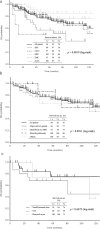Salivary gland-type cancers: cross-organ demographics of a rare cancer
- PMID: 38492066
- PMCID: PMC11130055
- DOI: 10.1007/s10147-024-02505-3
Salivary gland-type cancers: cross-organ demographics of a rare cancer
Abstract
Background: Salivary gland-type cancers (SGTCs) are histologically heterogeneous and can affect organs other than the salivary glands. Some tumors outside the salivary glands are diagnosed on their unique histological characteristics. Comprehensive cross-organ studies on SGTCs are limited.
Methods: We retrospectively analyzed the data of patients with salivary duct carcinoma (SDC), adenoid cystic carcinoma (AdCC), mucoepidermoid carcinoma (MEC), epithelial-myoepithelial carcinoma (EMC), acinic cell carcinoma (AcCC), and polymorphous adenocarcinoma (PAC) who visited our institution between 2009 and 2019. The primary tumor sites were classified into four categories; major salivary glands, head/neck (H/N) excluding (exc) major salivary glands (MSG) regions, broncho-pulmonary regions, and "others". H/N exc MSG was further divided into three subcategories, nasal/paranasal sinus, oral and pharynx/larynx.
Results: We identified 173 patients with SGTCs, with SDC, AdCC, MEC, EMC, AcCC, and PAC accounting for 20%, 42%, 27%, 3%, 8%, and 1% of the cases, respectively. The most frequent primary site was the major salivary glands (64%), followed by H/N exc MSG regions (27%), broncho-pulmonary regions, and "others", thus non-salivary gland origins accounted for 9% of all cases. Patients with SDC, MEC, AcCC, or SGTC of the major salivary glands and broncho-pulmonary regions were more frequently treated by surgery. The overall survival time of the patients with MEC was significantly better than that of patients with SDC or EMC.
Conclusions: This cross-organ study highlights the clinical significance of SGTCs, underscoring the need for developing novel therapies for this rare disease entity.
Keywords: Acinic cell carcinoma; Adenoid cystic carcinoma; Broncho-pulmonary; Cross-organ; Epithelial-myoepithelial carcinoma; Mucoepidermoid carcinoma.
© 2024. The Author(s).
Conflict of interest statement
In relation to conflict of interests pertaining to the present study, Izumi Ohno has received lecture fees from AstraZeneca, Daiichi-Sankyo, Novartis, Chugai pharmaceutical co., Ono pharmaceutical co., Bristol Meyers Squib, and Merck Sharp and Dohme. Toyoyuki Hanazawa has received lecture fees from Ono pharmaceutical co., and Merck Sharp and Dohme. Yuichi Takiguchi has received lecture fees from AstraZeneca, Daiichi-Sankyo, Novartis, Chugai pharmaceutical co., Bristol Meyers Squib, Pfizer, and Merck Sharp and Dohme, and research funds from AstraZeneca, Chugai pharmaceutical co., Ono pharmaceutical co., Pfizer, and Merck Sharp and Dohme. The other authors have no conflict of interests to declare.
Figures


Similar articles
-
Salivary gland epithelial neoplasms in pediatric population: a single-institute experience with a focus on the histologic spectrum and clinical outcome.Hum Pathol. 2017 Sep;67:37-44. doi: 10.1016/j.humpath.2017.07.007. Epub 2017 Jul 21. Hum Pathol. 2017. PMID: 28739497
-
Mucoepidermoid carcinoma, acinic cell carcinoma, and adenoid cystic carcinoma on fine-needle aspiration biopsy and The Milan System: an international multi-institutional study.J Am Soc Cytopathol. 2019 Sep-Oct;8(5):270-277. doi: 10.1016/j.jasc.2019.04.001. Epub 2019 Apr 9. J Am Soc Cytopathol. 2019. PMID: 31104944
-
Morphological heterogeneity of oral salivary gland carcinomas: a clinicopathologic study of 41 cases with long term follow-up emphasizing the overlapping spectrum of adenoid cystic carcinoma and polymorphous low-grade adenocarcinoma.Int J Clin Exp Pathol. 2011 Apr;4(4):336-48. Epub 2011 Apr 18. Int J Clin Exp Pathol. 2011. PMID: 21577319 Free PMC article.
-
Recent developments in the pathology of primary pulmonary salivary gland-type tumours.Histopathology. 2024 Jan;84(1):102-123. doi: 10.1111/his.15039. Epub 2023 Sep 11. Histopathology. 2024. PMID: 37694812 Review.
-
Role of Ancillary Techniques in the Differential Diagnosis of Salivary Gland Carcinomas.APMIS. 2025 Feb;133(2):e70008. doi: 10.1111/apm.70008. APMIS. 2025. PMID: 39967572 Review.
Cited by
-
Are HPV oncogenic viruses involved in salivary glands tumorigenesis?Rom J Morphol Embryol. 2024 Jul-Sep;65(3):395-407. doi: 10.47162/RJME.65.3.02. Rom J Morphol Embryol. 2024. PMID: 39529333 Free PMC article. Review.
References
-
- Cancer Information Service, National Cancer Center, Japan. Annual Survival Report of Hospital-Based Cancer Registries (2023) https://jhcr-cs.ganjoho.jp/hbcrtables/wpSiteSearch.aspx?UnitType=2. Accessed 15 Nov 2023
MeSH terms
Grants and funding
LinkOut - more resources
Full Text Sources
Medical

